There were a variety of sources used for this material including a few comments of our own.
FIVE MINUTES THAT DECIDED THE WAR IN THE PACIFIC.
The dive bombers usually get the bulk of the coverage. However what they achieved was put in motion as the result of the courage, dedication and sacrifice of 67 men of the three torpedo squadrons that arrived first and proceeded to attack (charge) the three Japanese carriers (The fourth Japanese Carrier was further away and not seen at this time) in obsolete planes, with unreliable torpedoes and little or no protection. This particular article is dedicated to them.
JAPANESE CARRIERS
The Japanese attacked Midway Island with planes from four Aircraft Carriers. The American Fleet was laying in wait for them and launched planes from three Aircraft Carriers. The Japanese Carriers Kaga, Akagi, Soryu, were all hit and fatally damaged by Navy dive bombers in approximately 5 minutes, 10:20 - 10:25 the morning of 4 June 1942. The fourth Japanese carrier the Hiryu, was found and sunk later in the day.
LOCAL CONNECTION
We know of at least one local man who was at the Battle of Midway in June 1942. Bill Sutherland, (ELO) who just passed a few months ago, was part of the crew of the Yorktown CV-5 that ultimately sank as a result of damage when torpedoed by a Japanese submarine during the battle of Midway. His next assignment, the USS Hornet CV-8, that carried the bombers to near Japan and launched them (Doolittle Raid), was sunk in October 1942 at the Battle of Santa Cruzalso.
The Charge of the Light Brigade, Picketts's charge, Charge at Krojanty and probably more than one of the WWI trench warfare charges by the Brits against the Germans or the Germans against the Brits had several common elements. The side advancing showed tremendous courage, and dedication to duty, suffered tremendously high causalities, those they were advancing against had a better position, or had better equipment, or were better trained and the advancing side did not achieve their goal or maybe I should say their primary goal.
There is such as that described above in the WWII history of the US Navy. It had what could be called a "charge", suffered 95% causality rate. Those "charging" were seriously out numbered, were using obsolete equipment, were in effect sitting ducks. Those they were attacking had more and better equipment. The attacking side never wavered in carrying our their duty. They showed tremendous courage, and dedication. The attackers failed totally to achieve their primary goal, however it could be arguably said what they did do that day caused the Japanese to lose the war in the Pacific. I am putting this together because I feel those men should be honored, their names should be preserved and known.
The plane: TBD Devastator Torpedo Bomber
http://www.boeing.com/boeing/history/mdc/tbd.page
The pilots and radiomen/gunners.
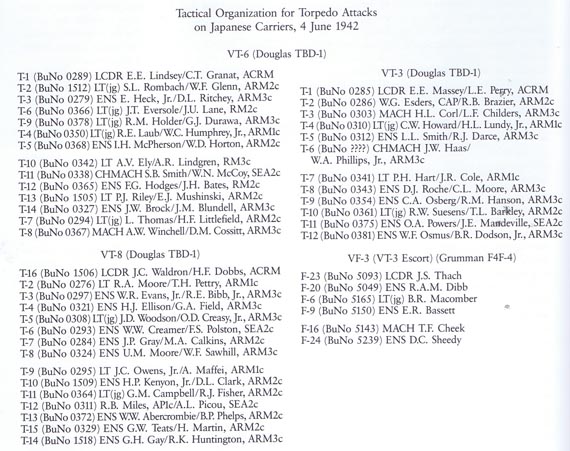
John Ford, The Battle of Midway.
http://archive.org/details/BattleOfMidway
VT-8
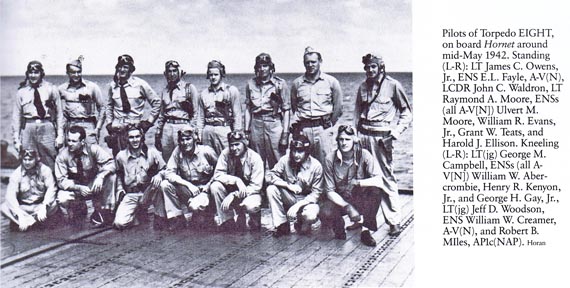
From: http://en.wikipedia.org/wiki/VT-8:
A list of the fallen, Pilots: Lt. Commander John C. Waldron, Lt. Raymond A. Moore, Lt. James C. Owens, Jr., Lt.(jg) George M. Campbell, Lt.(jg) John P. Gray, Lt.(jg) Jeff D. Woodson, Ens. William W. Abercrombie, Ens. William W. Creamer, Ens. Harold J. Ellison, Ens. William R. Evans, Ens. Henry R. Kenyon, Ens. Ulvert M. Moore, Ens. Grant W. Teats, Robert B. Miles, Aviation Pilot 1c. Radiomen/gunners: Horace F. Dobbs, Chief Radioman, Amelio Maffei, Radioman 1, Tom H. Pettry, Radioman 1, Otway D. Creasy, Jr. Radioman 2, Ross H. Bibb, Jr., Radioman 2, Darwin L. Clark, Radioman 2, Ronald J. Fisher, Radioman 2, Hollis Martin, Radioman 2, Bernerd P. Phelps Radioman 2, Aswell L. Picou, Seaman 2, Francis S. Polston, Seaman 2, Max A. Calkins, Radioman 3, George A. Field, Radioman 3, Robert K. Huntington, Radioman 3, William F. Sawhill, Radioman 3.
At about 0915, the Japanese fleet changed course to get closer to the American fleet which they had learned was present. This change in course enabled the U.S. Navy carrier planes, which were getting low of fuel, to discover the Japanese fleet and 3 of the 4 Japanese carriers. Shortly thereafter, fifteen TBD-1 "Devastators" of Lieutenant Commander John C. Waldron's Torpedo Squadron Eight (VT-8), from USS Hornet, bravely pressed their attack against a swarm of nimble and deadly "Zero" fighters.
From "The First Team, Pacific Naval Air Combat from Pearl Harbor to Midway. John B. Lundstrom Navy Institute Press (1984) pp 342-43":
Torpedo Eight went gallantly to its doom. Waldron took his fifteen TBDs down to the wave tops to make a "low approach" in order to keep some of the fighters off. The Japanese were heading toward him, making the deployment of the torpedo planes necessarily swift. Waldron first thought to execute a split attack and motioned Lieut. James C. Owens's 2nd Division to move out to the right. The Zeros responded so fiercely that Waldron recalled Owens and formed his planes tightly in an echelon of divisions—a spearhead aimed at the nearest enemy flattop, which proved to, be the Soryü. The Japanese CAP aloft was eighteen Zeros; the Akagi and the Kaga scrambled an additional eleven. Soon the Zeros had splashed a TBD from the 1st Division. Over the radio Waldron inquired whether a TBD or a Zero had gone in. He was told it was one of his. . .
Lt. Cdr. Itaya Shigeru's fighters (the Akagi's for the most part) methodically tore into Torpedo Eight with a succession of shattering attacks from above and behind—wolves ripping into a herd of deer. The TBDs, "flying freight cars bearing the white star,"' could only go low and slow. Two more Devastators smacked the water; then a Zero punctured Waidron's left wing tank, flaming the aircraft. The skipper flew into the waves. Finally fighters and antiaircraft fire whittled the formation down to one, the TBD flown by Ens. George H. ("Tex") Gay. He turned slightly to take the nearest carrier (the Soryu) from her starboard side and pulled the torpedo release at 800 yards. Torpedo Eight scored no hits on enemy ships. Five Zeros just scrambled from the Akagi jumped Gay not far from his target and sent him into the water. All fifteen TBDs had splashed, and only one man survived—Tex Gay.
Not a plane survived this magnificent devotion to purpose. One pilot, [Ensign Gay]after attacking and probably hitting the Kaga at close range, with his gunner already killed, crashed near the Akagi, ducked under his seat cushion to prevent being machine gunned, and from this reserved position observed the fierce attacks that followed.
Gay's torperdo and perhaps even some of the torpedoes dropped by other pilots of VT-8, VT-3 and VT-6 that day may have hit these three Japanese carriers but not a single torpedo exploded against the said of any of those 3 carriers. The US Torpedoes of early WWII were unreliable. They were prone to run too deep, thus passing underneath a target, run erratically meaning they could curve off target and or fail to explode upon impact.
The toll
Fifteen Planes, thirty men. Twenty-nine men lost. No planes returned, One man survived. Damage inflicted on Japanese carriers, none.
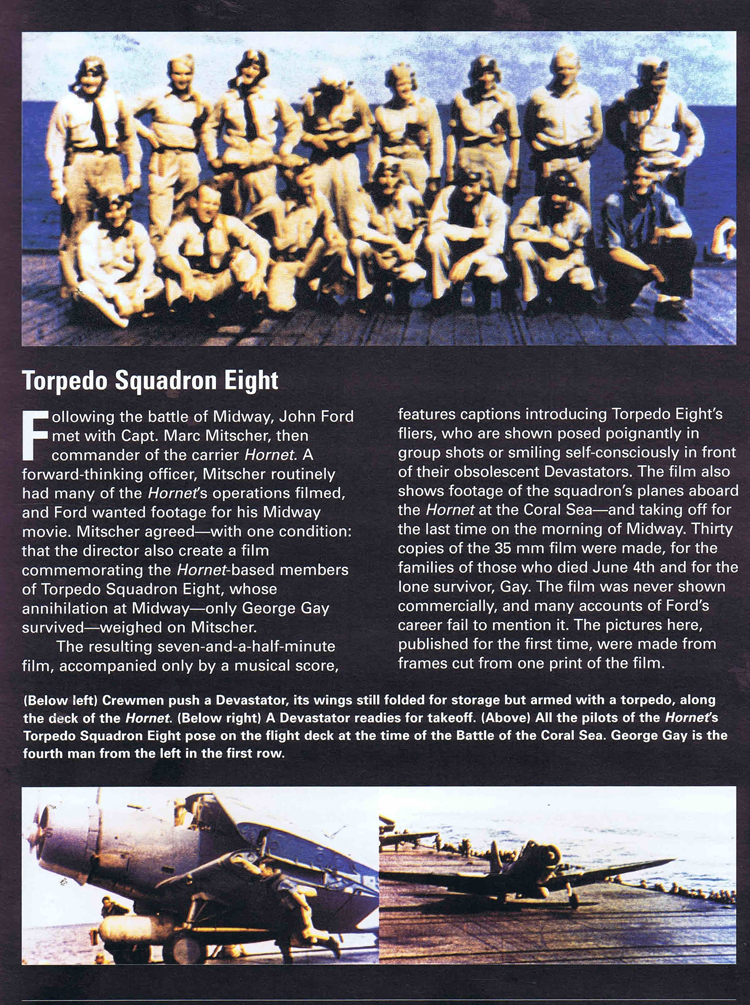
Courtesy of Return to Midway, Robert D. Ballard and Rick Archbold. National Geographic Madison Press p81, (1999)
https://www.youtube.com/watch?v=IsK1PeoMfNQ
John Ford's Tribute to Torpedo Squadron 8
ENSIGN GEORGE H. GAY
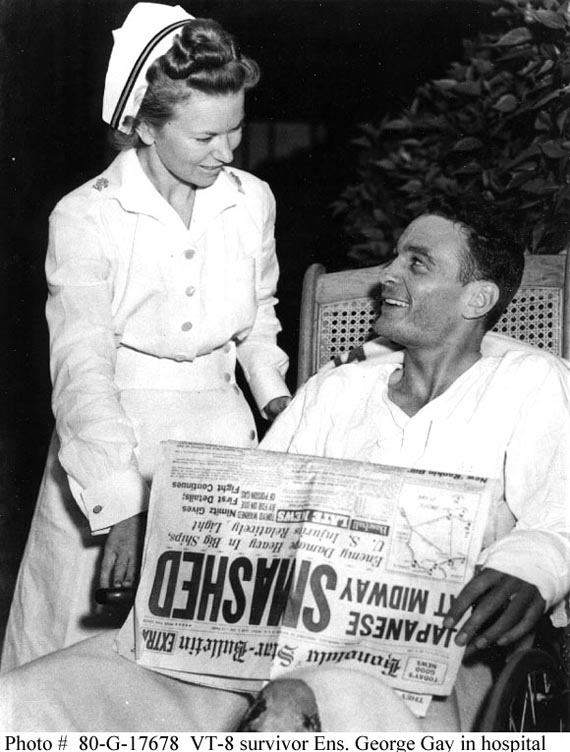
Photo #: 80-G-17678 Battle of Midway, June 1942 Ensign George H. Gay at Pearl Harbor Naval Hospital, with a nurse and a copy of the "Honolulu Star-Bulletin" newspaper featuring accounts of the battle. He was the only survivor of the 4 June 1942 Torpedo Squadron Eight (VT-8) TBD torpedo plane attack on the Japanese carrier force. Gay's book "Sole Survivor" indicates that the date of this photograph is probably 7 June 1942, following an operation to repair his injured left hand and a meeting with Admiral Chester W. Nimitz. Official U.S. Navy Photograph, U.S. National Archives Collection. Online Image: 86KB; 580 x 765 Reproductions may also be available at National Archives.
The sole survivor of VT-8
http://www.defensemedianetwork.com/stories/midway-the-sole-survivor-of-torpedo-squadron-8/
VT-3
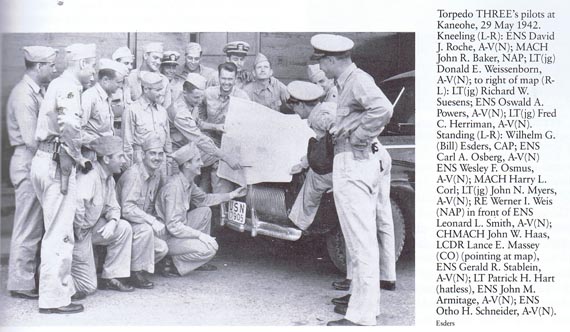
Only two planes escaped from Lieutenant Commander Lance E. Massey's Torpedo Squadron Three (VT-3), from USS Yorktown. Six Fighting Squadron Three (VF-3) F4F-4 "Wildcats", led by Lieutenant Commander John S. Thach, tried to help VT-3, but were so badly outnumbered by "Zeros" that they could not be of much assistance.
After the picture was taken there was some changes of personnel: The following names are the names of the men who died; Pilots: Massey Lance Edward 063292 LCDR MIA 6222 06/04/42 VT-3, Osmus Wesley Frank 085937 ENS KIA 2337 06/05/42 VT-3, Powers Oswald Aaron 098791 ENS MIA 6222 06/04/42 VT-3, Roche David John 084010 ENS MIA 6222 06/04/42 VT-3, Smith Leonard Leroy 098528 ENS MIA 6222 06/04/42 VT-3, Hart Patrick Henry 078621 LT MIA 6222 06/04/42 VT-3, Haas John William 146612 CWO MIA 6222 06/04/42 VT-3, Suesens Rich Wayne 081622 LTJG MIA 6222 06/04/42 VT-3, Howard Curtis William 081335 LTJG MIA 6222 06/04/42 VT-3, Osberg Carl August 099914 ENS MIA 6222 06/04/42 VT-3, Osmus Wesley Frank 085937 ENS KIA 2337 06/05/42 VT-3. Radiomen/gunner: Barkley Troy L 2955303 ARM2 MIA 6222 06/04/42 VT-3, Brazier Robert Boyd 3684562 ARM2 KIA 0121 06/04/42 VT-3, Cole Johnnie Ralph 2682433 ARM1 MIA 6222 06/04/42 VT-3, Darce Raymond Joseph 6440095 ARM3 MIA 6222 06/04/42 VT-3, Dodson Benjamin Ross Jr 2628803 ARM3 MIA 6222 06/04/42 VT-3, Hansen Richard Matthew 6620165 ARM3 MIA 6222 06/04/42 VT-3, Lundy Harold Cheuvrant Jr 3165529 ARM1 MIA 6222 06/04/42 VT-3, Mandeville Joseph Emile 2018988 SEA2 MIA 6222 06/04/42 VT-3, Moore Charles Lee 3563659 ARM3 MIA 6222 06/04/42 VT-3, Perry Leonard Edward Jr 3161797 ACRMA MIA 6222 06/04/42 VT-3, Phillips William Albert 6640113 ARM3 MIA 6222 06/04/42 VT-3. There is one pilot and radioman/gunner too many.
File:TBD VT-3 Midway.jpg
https://commons.wikimedia.org/wiki/File:TBD_VT-3_Midway.jpg
From: http://www.history.navy.mil/docs/wwii/mid7.htm
VT-3 - 12 TBD's - Lt.Comdr. L.E. Massey, USN. (b) Torpedo Attack.
approached the enemy force on course 345° and when about 14 miles from the objective were attacked by Zero fighters. The squadron maneuvered to avoid the fighters and decreased altitude to 150 feet to avoid attacks from below. When about one mile to the Eastward of the target (enemy CV), the squadron commander turned towards the CV and commenced his attack. At this point he was shot down in flames by enemy VF, the remainder of the planes continued the attack. Only 5 VT dropped their torpedoes, as 7 were shot down during the approach and 3 more after the attack. The Fighter Squadron Commander stated that he saw 3 torpedo hits on the large CV to he Eastward and one on the small CV in the middle of the formation. It is estimated that the VT squadron was attacked by at least 8 Zero fighters and shot down at least one Zero fighter.
1
0 VT lost in vicinity of enemy fleet, Pilots missing 10; rear seat men 10, killed. d) Torpedo Airplanes. It is believed that this engagement showed clearly the vulnerability of TBD's, for out of 12 TBD's sent into attack, only two are known to have left the vicinity of the battle.
Toll
Twelve planes, 10 lost, 20 men lost. Two planes 4 men returned, no damage done to the Japanese carriers.
VT-6
USS Enterprise's Torpedo Squadron Six (VT-6), led by Lieutenant Commander Eugene E. Lindsey, unsuccessfully pursued Kaga, losing all but five of fourteen TBDs to the Japanese defenses.
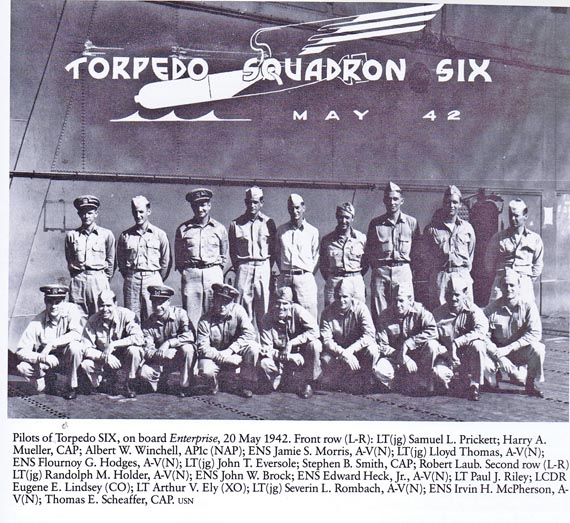
From "The First Team, Pacific Naval Air Combat from Pearl Harbor to Midway. John B. Lundstrom Navy Institute Press (1984) pp 343":
While Torpedo Eight had gone almost straight to the enemy and attacked, Gene Lindsey's Torpedo Six flew southwest along the heading of 240 degrees. Visibility had improved somewhat since McClusky's Enterprise SBDs had passed south of VT-6's flight path. Not long after 0930, Torpedo Six observed smoke about 30 miles to the northwest, and Lindsey turned right to investigate. Soon he came upon KidO Butai and discerned three flattops loosely surrounded by heavy cruisers, all of the enemy ships steaming away at high speed to the northeast. Because of the Japanese course change at 0915, they had nearly slipped past Torpedo Six, which was now south of them. Lindsey aimed for the nearest flattop (the Kaga), but the rate of closure was agonizingly slow. TBDs at 100 or so knots chasing ships making 30 knots. He decided on a split attack and sent Art Ely's 2nd Division farther to the north to circle around the target's port side. Aloft the CAP comprised twenty- seven Zeros, some about to land. Lookouts spotted the oncoming TBDs at 0938, and two minutes later the Tone opened fire with her main battery to direct the Zeros after them. The Akagi and the Soryü at 0945 launched seven fighters to reinforce the CAP. During Lindsey's run in, however, his main tormentors would he Itaya's Akagi Zeros.
While the VF-6 pilots had circled unknowingly not far away, Torpedo Six had braved the fierce enemy fighter defense. Both Lindsey and Ely radioed for fighter support, but Gray and his pilots never heard them. As they had with VT-8's attack, the Japanese fighter pilots demonstrated skill and determination in working over the hapless TBDs. One after another the clumsy Devastators took mortal damage and plunged into the sea. Both Lindsey and Ely went down at the head of their men. After 0958, the surviving TBDs finally got close enough to threaten the Akagi and the Kaga, having traversed the center of the Japanese formation from west to east. Five or six of VT-6's planes launched their fish, but the attack angles were poor because of adroit enemy ship handling. That and the unreliable American torpedoes assured no hits. The Akagi and Soryu Zeros harried VT-6's withdrawal, so the getaway took almost as long as the approach. Five TBDs cleared the hell of KidO Butai; the other nine had splashed. One of the five survivors later ditched, but its crew was eventually rescued. Drawing away from the slashing fighter attacks and antiaircraft fire, the remaining aircrews of Torpedo Six felt betrayed. They had lacked fighter support, although they definitely had expected an escort.
Toll
Fourteen TBDs, 10 lost, 9 in the attack and one from damage sustained in the attack on the flignt back to the Enterprise. 18 men lost.
ATROCITIES
From: Battle of Midway and the Aleutian Islands: http://ww2db.com/battle_spec.php?battle_id=6
Ensign Wesley F. Osmus, who piloted a TBD Devastator against Soryu, was shot down and rescued by Japanese destroyer Arashi. Suffering only minor burns as reported by Arashi's doctor Lieutenant Katsukichi Ishizaka, he was interrogated for intelligence, which included information regarding Yorktown's location and strength. Upon completion of the interrogation, Commander Kosaku Ariga, commanding officer of Arashi, ordered Osmus' execution. He was thrown overboard, but in desperation to save his own life he held on to the railings and refused to let go. One of the Japanese sailors took a fire-axe and killed him with a blow to the back of his head. Osmus was not the only victim of Japanese atrocities during the Battle of Midway. Ensign Frank O'Flaherty and his radioman Bruno Gaido also survived the crashing of their aircraft (SBD Dauntless dive bomber) to be picked up by the Japanese. For six days they were interrogated, though treated reasonably well by Ensign Koju Kanechiku, an officer at the brig of destroyer Makigumo, but they were ultimately thrown overboard with five gallon kerosene cans filed with sea water attached to their bodies.
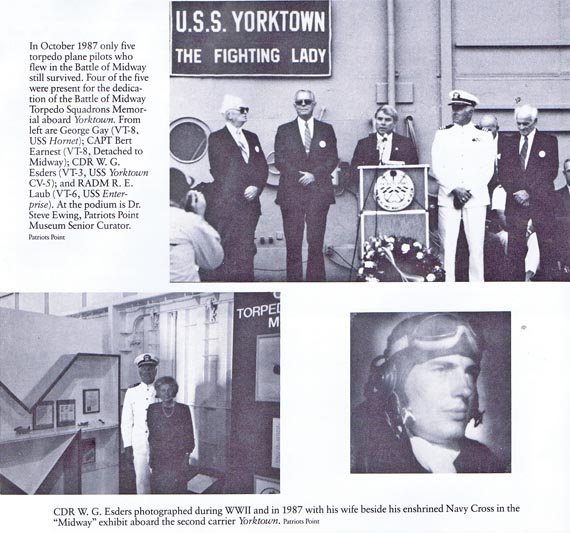
.jpg)
SUMMATION
fROM: http://militaryhistory.about.com/od/worldwariiaircraft/p/World-War-Ii-Tbd-Devastator.htm
Attacking without cover, they suffered horrific losses to Japanese A6M "Zero" fighters and anti-aircraft fire. Though failing to score any hits, their attack pulled the Japanese combat air patrol out of position, leaving the fleet vulnerable. At 10:22 AM, American SBD Dauntless dive bombers approaching from the southwest and northeast struck the carriers Kaga, Soryu, and Akagi. In less than six minutes they reduced the Japanese ships to burning wrecks. Of the 39 TBDs sent against the Japanese, only 5 returned. In the attack, USS Hornet's VT-8 lost all 15 aircraft with Ensign George Gay being the only survivor.
In the wake of Midway, the US Navy withdrew its remaining TBDs and squadrons transitioned to the newly arriving Avenger. The 39 TBDs remaining in the inventory were assigned to training roles in the United States and by 1944 the type was no longer in the US Navy's inventory. Often believed to have been a failure, the TBD Devastator's principal fault was simply being old and obsolete. BuAir was aware of this fact and the aircraft's replacement was en route when the Devastator's career ingloriously ended.
From: http://www.fisthistory.org/Midway.htm
Yet, their sacrifice won the battle!
Japanese fighters were pulled down from altitude to stop the attacking torpedo aircraft from Midway Island, followed by the carrier-based Devastators. Maneuvering to avoid the torpedo attacks, Japanese preparations to attack the American carriers was delayed. Shortly, three Japanese carriers, Soryu, Akagi, and Kaga, were left sinking by SBD Dauntless squadrons from ENTERPRISE and YORKTOWN that made unopposed dives and dropped their bombs on the decks of Japanese ships loaded with aircraft preparing to launch against the American carriers.
partially repaired YORKTOWN, while ENTERPRISE and HORNET Air Groups were ending Hiryu’s usefulness to the Empire. The Japanese Navy never recovered from the loss of these four ships and their experienced aircrews. The TBD passed into history, but not the heroism of those 67 torpedo squadron crewmen and those crews from Midway Island who died in the service of their country.
Unfortunately, We have not been able to find a list of those who were killed from VT-6. But I will continue to look.
This site is the property of the East Liverpool Historical Society.
Regular linking, i.e. providing the URL of the East Liverpool Historical Society web site for viewers to click on and be taken to the East Liverpool Historical Society entry portal or to any specific article on the website is legally permitted.
Hyperlinking, or as it is also called framing, without permission is not permitted.
Legally speaking framing is still in a murky area of the law though there have been court cases in which framing has been seen as violation of copyright law. Many cases that were taken to court ended up settling out-of-court with the one doing the framing agreeing to cease framing and to just use a regular link to the other site.
The East Liverpool Historical Society pays fees to keep their site online. A person framing the Society site is effectively presenting the entire East Liverpool Historical Society web site as his own site and doing it at no cost to himself, i.e. stealing the site.
The East Liverpool Historical Society reserves the right to charge such an individual a fee for the use of the Society’s material.